sensor LINCOLN MKS 2016 Service Manual
[x] Cancel search | Manufacturer: LINCOLN, Model Year: 2016, Model line: MKS, Model: LINCOLN MKS 2016Pages: 382, PDF Size: 3.81 MB
Page 192 of 382
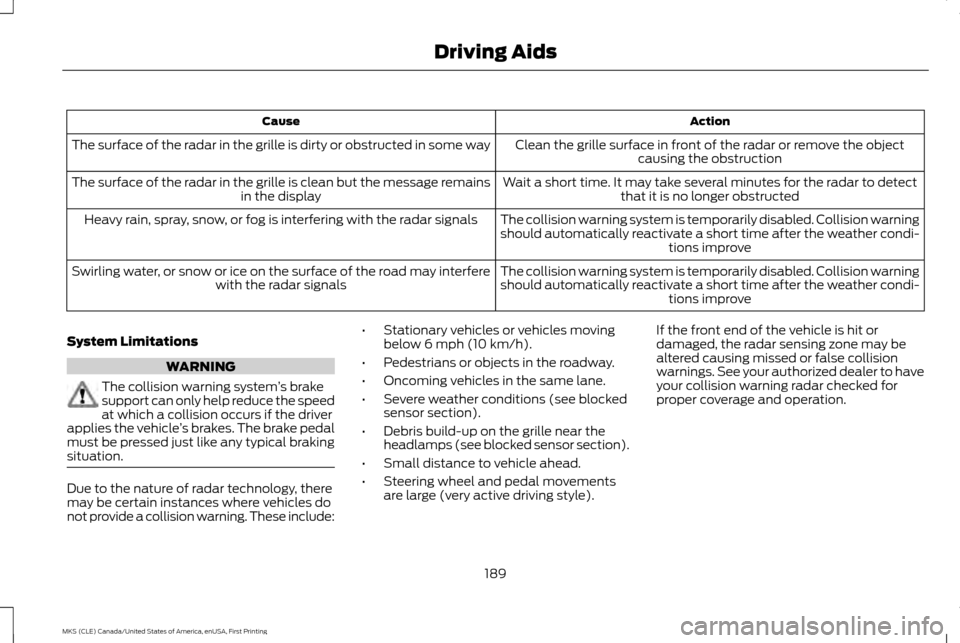
Action
Cause
Clean the grille surface in front of the radar or remove the objectcausing the obstruction
The surface of the radar in the grille is dirty or obstructed in some way
Wait a short time. It may take several minutes for the radar to detectthat it is no longer obstructed
The surface of the radar in the grille is clean but the message remains
in the display
The collision warning system is temporarily disabled. Collision warning
should automatically reactivate a short time after the weather condi-tions improve
Heavy rain, spray, snow, or fog is interfering with the radar signals
The collision warning system is temporarily disabled. Collision warning
should automatically reactivate a short time after the weather condi-tions improve
Swirling water, or snow or ice on the surface of the road may interfere
with the radar signals
System Limitations WARNING
The collision warning system
’s brake
support can only help reduce the speed
at which a collision occurs if the driver
applies the vehicle ’s brakes. The brake pedal
must be pressed just like any typical braking
situation. Due to the nature of radar technology, there
may be certain instances where vehicles do
not provide a collision warning. These include: •
Stationary vehicles or vehicles moving
below 6 mph (10 km/h).
• Pedestrians or objects in the roadway.
• Oncoming vehicles in the same lane.
• Severe weather conditions (see blocked
sensor section).
• Debris build-up on the grille near the
headlamps (see blocked sensor section).
• Small distance to vehicle ahead.
• Steering wheel and pedal movements
are large (very active driving style). If the front end of the vehicle is hit or
damaged, the radar sensing zone may be
altered causing missed or false collision
warnings. See your authorized dealer to have
your collision warning radar checked for
proper coverage and operation.
189
MKS (CLE) Canada/United States of America, enUSA, First Printing Driving Aids
Page 229 of 382
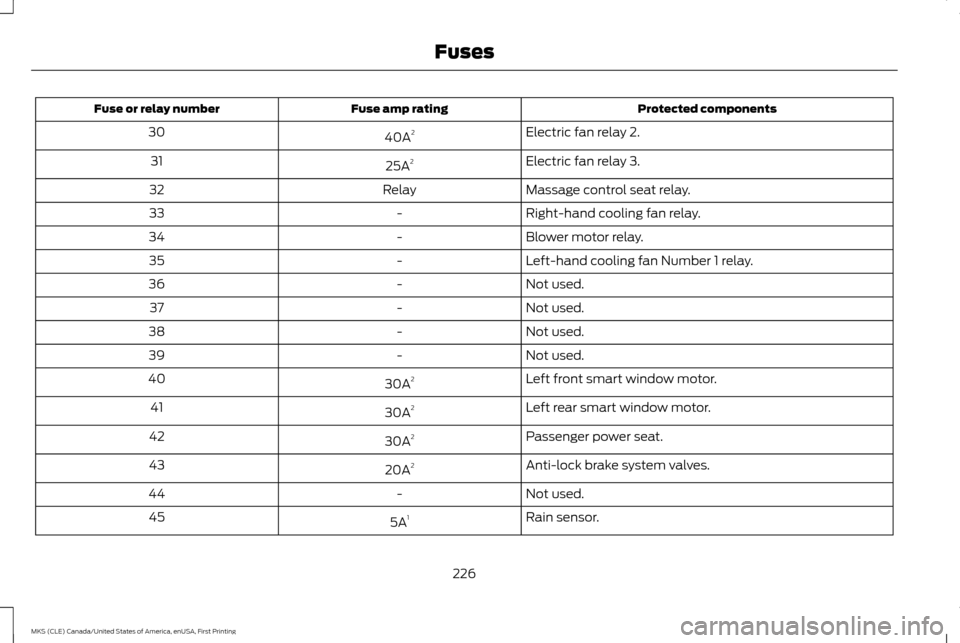
Protected components
Fuse amp rating
Fuse or relay number
Electric fan relay 2.
40A 2
30
Electric fan relay 3.
25A 2
31
Massage control seat relay.
Relay
32
Right-hand cooling fan relay.
-
33
Blower motor relay.
-
34
Left-hand cooling fan Number 1 relay.
-
35
Not used.
-
36
Not used.
-
37
Not used.
-
38
Not used.
-
39
Left front smart window motor.
30A 2
40
Left rear smart window motor.
30A 2
41
Passenger power seat.
30A 2
42
Anti-lock brake system valves.
20A 2
43
Not used.
-
44
Rain sensor.
5A 1
45
226
MKS (CLE) Canada/United States of America, enUSA, First Printing Fuses
Page 231 of 382
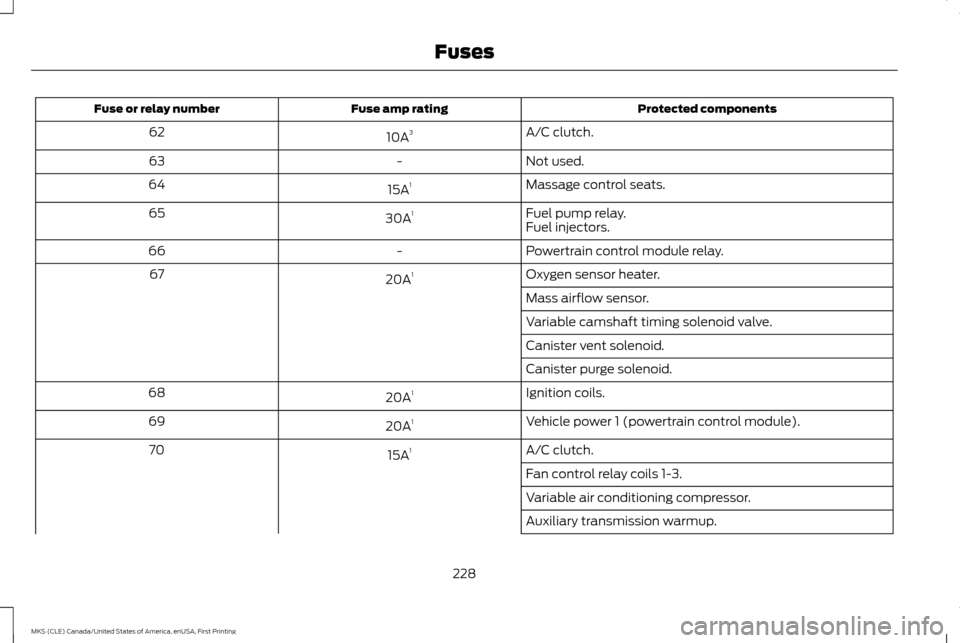
Protected components
Fuse amp rating
Fuse or relay number
A/C clutch.
10A 3
62
Not used.
-
63
Massage control seats.
15A 1
64
Fuel pump relay.
30A 1
65
Fuel injectors.
Powertrain control module relay.
-
66
Oxygen sensor heater.
20A 1
67
Mass airflow sensor.
Variable camshaft timing solenoid valve.
Canister vent solenoid.
Canister purge solenoid.
Ignition coils.
20A 1
68
Vehicle power 1 (powertrain control module).
20A 1
69
A/C clutch.
15A 1
70
Fan control relay coils 1-3.
Variable air conditioning compressor.
Auxiliary transmission warmup.
228
MKS (CLE) Canada/United States of America, enUSA, First Printing Fuses
Page 238 of 382
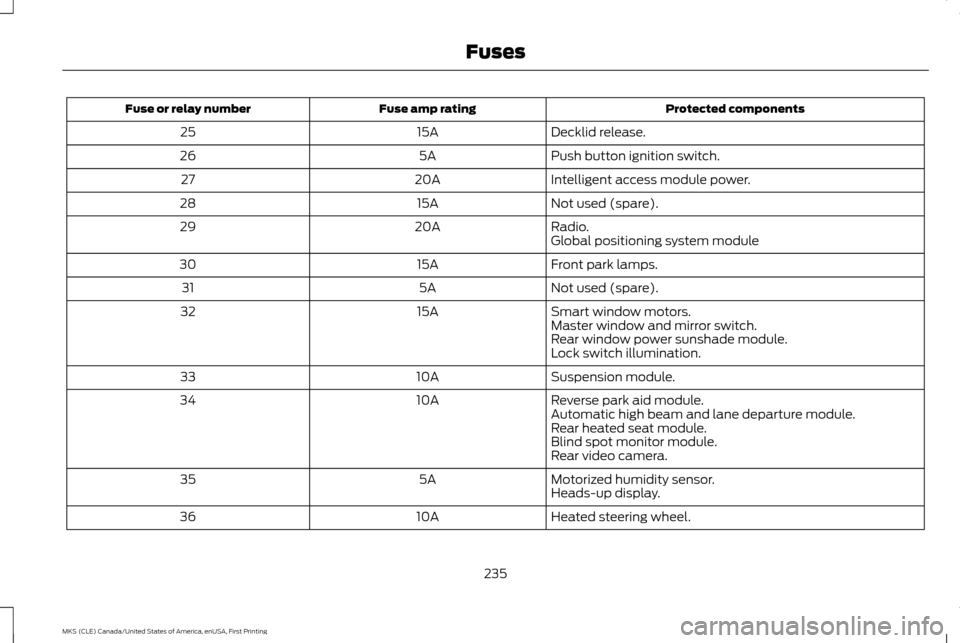
Protected components
Fuse amp rating
Fuse or relay number
Decklid release.
15A
25
Push button ignition switch.
5A
26
Intelligent access module power.
20A
27
Not used (spare).
15A
28
Radio.
20A
29
Global positioning system module
Front park lamps.
15A
30
Not used (spare).
5A
31
Smart window motors.
15A
32
Master window and mirror switch.
Rear window power sunshade module.
Lock switch illumination.
Suspension module.
10A
33
Reverse park aid module.
10A
34
Automatic high beam and lane departure module.
Rear heated seat module.
Blind spot monitor module.
Rear video camera.
Motorized humidity sensor.
5A
35
Heads-up display.
Heated steering wheel.
10A
36
235
MKS (CLE) Canada/United States of America, enUSA, First Printing Fuses
Page 239 of 382
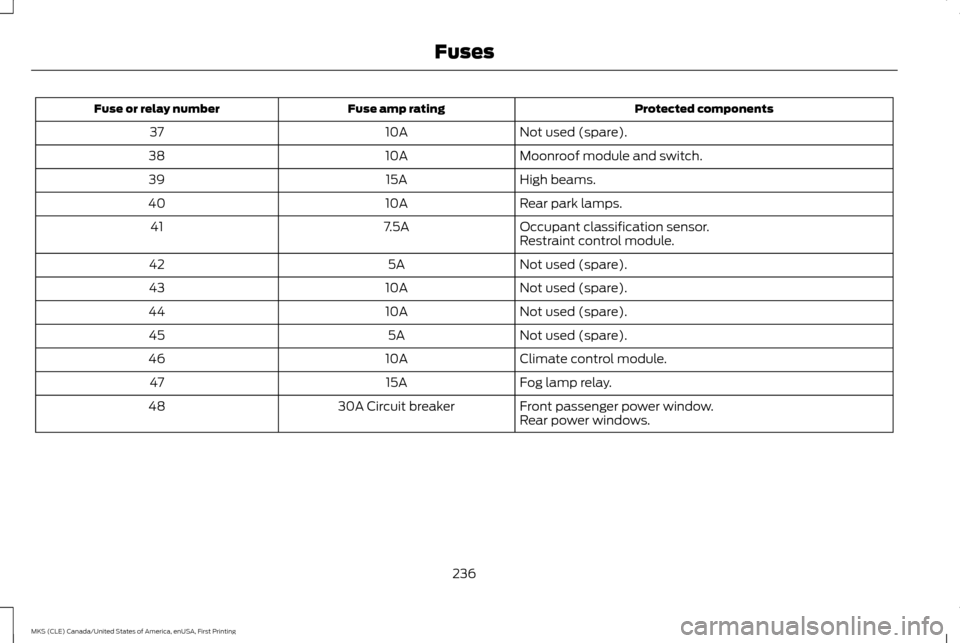
Protected components
Fuse amp rating
Fuse or relay number
Not used (spare).
10A
37
Moonroof module and switch.
10A
38
High beams.
15A
39
Rear park lamps.
10A
40
Occupant classification sensor.
7.5A
41
Restraint control module.
Not used (spare).
5A
42
Not used (spare).
10A
43
Not used (spare).
10A
44
Not used (spare).
5A
45
Climate control module.
10A
46
Fog lamp relay.
15A
47
Front passenger power window.
30A Circuit breaker
48
Rear power windows.
236
MKS (CLE) Canada/United States of America, enUSA, First Printing Fuses
Page 255 of 382
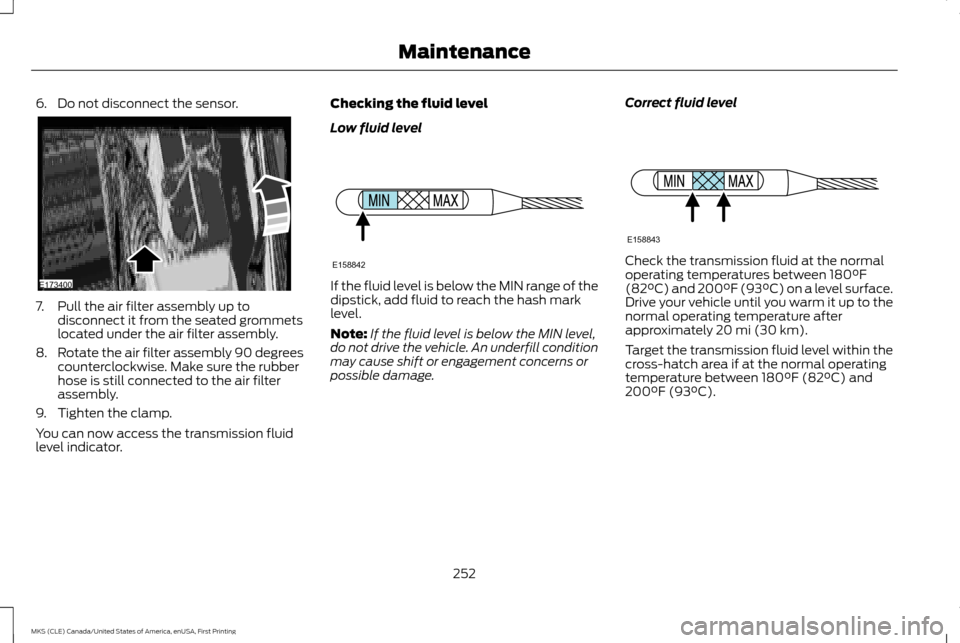
6. Do not disconnect the sensor.
7. Pull the air filter assembly up to
disconnect it from the seated grommets
located under the air filter assembly.
8. Rotate the air filter assembly 90 degrees
counterclockwise. Make sure the rubber
hose is still connected to the air filter
assembly.
9. Tighten the clamp.
You can now access the transmission fluid
level indicator. Checking the fluid level
Low fluid level
If the fluid level is below the MIN range of the
dipstick, add fluid to reach the hash mark
level.
Note:
If the fluid level is below the MIN level,
do not drive the vehicle. An underfill condition
may cause shift or engagement concerns or
possible damage. Correct fluid level Check the transmission fluid at the normal
operating temperatures between 180°F
(82°C) and 200°F (93°C) on a level surface.
Drive your vehicle until you warm it up to the
normal operating temperature after
approximately 20 mi (30 km).
Target the transmission fluid level within the
cross-hatch area if at the normal operating
temperature between 180°F (82°C) and
200°F (93°C).
252
MKS (CLE) Canada/United States of America, enUSA, First Printing MaintenanceE173400 E158842 E158843
Page 287 of 382
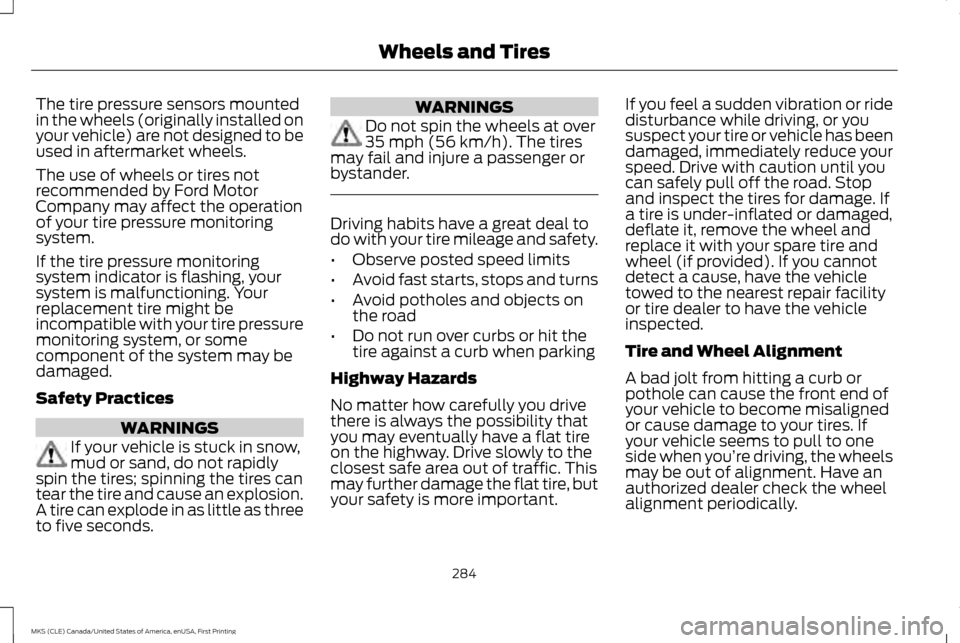
The tire pressure sensors mounted
in the wheels (originally installed on
your vehicle) are not designed to be
used in aftermarket wheels.
The use of wheels or tires not
recommended by Ford Motor
Company may affect the operation
of your tire pressure monitoring
system.
If the tire pressure monitoring
system indicator is flashing, your
system is malfunctioning. Your
replacement tire might be
incompatible with your tire pressure
monitoring system, or some
component of the system may be
damaged.
Safety Practices
WARNINGS
If your vehicle is stuck in snow,
mud or sand, do not rapidly
spin the tires; spinning the tires can
tear the tire and cause an explosion.
A tire can explode in as little as three
to five seconds. WARNINGS
Do not spin the wheels at over
35 mph (56 km/h). The tires
may fail and injure a passenger or
bystander. Driving habits have a great deal to
do with your tire mileage and safety.
•
Observe posted speed limits
• Avoid fast starts, stops and turns
• Avoid potholes and objects on
the road
• Do not run over curbs or hit the
tire against a curb when parking
Highway Hazards
No matter how carefully you drive
there is always the possibility that
you may eventually have a flat tire
on the highway. Drive slowly to the
closest safe area out of traffic. This
may further damage the flat tire, but
your safety is more important. If you feel a sudden vibration or ride
disturbance while driving, or you
suspect your tire or vehicle has been
damaged, immediately reduce your
speed. Drive with caution until you
can safely pull off the road. Stop
and inspect the tires for damage. If
a tire is under-inflated or damaged,
deflate it, remove the wheel and
replace it with your spare tire and
wheel (if provided). If you cannot
detect a cause, have the vehicle
towed to the nearest repair facility
or tire dealer to have the vehicle
inspected.
Tire and Wheel Alignment
A bad jolt from hitting a curb or
pothole can cause the front end of
your vehicle to become misaligned
or cause damage to your tires. If
your vehicle seems to pull to one
side when you’re driving, the wheels
may be out of alignment. Have an
authorized dealer check the wheel
alignment periodically.
284
MKS (CLE) Canada/United States of America, enUSA, First Printing Wheels and Tires
Page 290 of 382
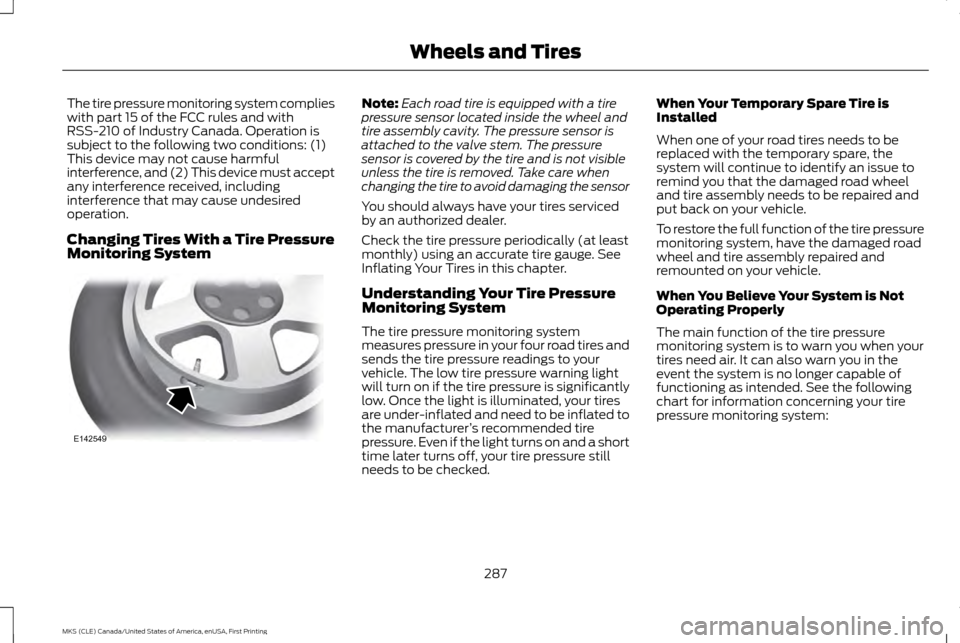
The tire pressure monitoring system complies
with part 15 of the FCC rules and with
RSS-210 of Industry Canada. Operation is
subject to the following two conditions: (1)
This device may not cause harmful
interference, and (2) This device must accept
any interference received, including
interference that may cause undesired
operation.
Changing Tires With a Tire Pressure
Monitoring System Note:
Each road tire is equipped with a tire
pressure sensor located inside the wheel and
tire assembly cavity. The pressure sensor is
attached to the valve stem. The pressure
sensor is covered by the tire and is not visible
unless the tire is removed. Take care when
changing the tire to avoid damaging the sensor
You should always have your tires serviced
by an authorized dealer.
Check the tire pressure periodically (at least
monthly) using an accurate tire gauge. See
Inflating Your Tires in this chapter.
Understanding Your Tire Pressure
Monitoring System
The tire pressure monitoring system
measures pressure in your four road tires and
sends the tire pressure readings to your
vehicle. The low tire pressure warning light
will turn on if the tire pressure is significantly
low. Once the light is illuminated, your tires
are under-inflated and need to be inflated to
the manufacturer ’s recommended tire
pressure. Even if the light turns on and a short
time later turns off, your tire pressure still
needs to be checked. When Your Temporary Spare Tire is
Installed
When one of your road tires needs to be
replaced with the temporary spare, the
system will continue to identify an issue to
remind you that the damaged road wheel
and tire assembly needs to be repaired and
put back on your vehicle.
To restore the full function of the tire pressure
monitoring system, have the damaged road
wheel and tire assembly repaired and
remounted on your vehicle.
When You Believe Your System is Not
Operating Properly
The main function of the tire pressure
monitoring system is to warn you when your
tires need air. It can also warn you in the
event the system is no longer capable of
functioning as intended. See the following
chart for information concerning your tire
pressure monitoring system:
287
MKS (CLE) Canada/United States of America, enUSA, First Printing Wheels and TiresE142549
Page 292 of 382
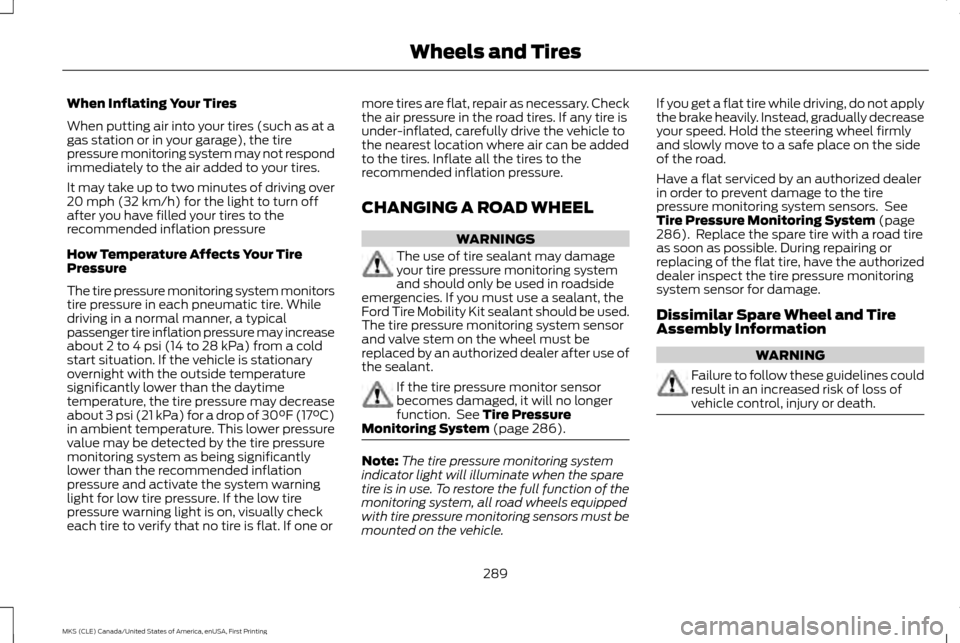
When Inflating Your Tires
When putting air into your tires (such as at a
gas station or in your garage), the tire
pressure monitoring system may not respond
immediately to the air added to your tires.
It may take up to two minutes of driving over
20 mph (32 km/h) for the light to turn off
after you have filled your tires to the
recommended inflation pressure
How Temperature Affects Your Tire
Pressure
The tire pressure monitoring system monitors
tire pressure in each pneumatic tire. While
driving in a normal manner, a typical
passenger tire inflation pressure may increase
about 2 to 4 psi (14 to 28 kPa) from a cold
start situation. If the vehicle is stationary
overnight with the outside temperature
significantly lower than the daytime
temperature, the tire pressure may decrease
about 3 psi (21 kPa) for a drop of 30°F (17°C)
in ambient temperature. This lower pressure
value may be detected by the tire pressure
monitoring system as being significantly
lower than the recommended inflation
pressure and activate the system warning
light for low tire pressure. If the low tire
pressure warning light is on, visually check
each tire to verify that no tire is flat. If one or
more tires are flat, repair as necessary. Check
the air pressure in the road tires. If any tire is
under-inflated, carefully drive the vehicle to
the nearest location where air can be added
to the tires. Inflate all the tires to the
recommended inflation pressure.
CHANGING A ROAD WHEEL
WARNINGS
The use of tire sealant may damage
your tire pressure monitoring system
and should only be used in roadside
emergencies. If you must use a sealant, the
Ford Tire Mobility Kit sealant should be used.
The tire pressure monitoring system sensor
and valve stem on the wheel must be
replaced by an authorized dealer after use of
the sealant. If the tire pressure monitor sensor
becomes damaged, it will no longer
function. See Tire Pressure
Monitoring System (page 286). Note:
The tire pressure monitoring system
indicator light will illuminate when the spare
tire is in use. To restore the full function of the
monitoring system, all road wheels equipped
with tire pressure monitoring sensors must be
mounted on the vehicle. If you get a flat tire while driving, do not apply
the brake heavily. Instead, gradually decrease
your speed. Hold the steering wheel firmly
and slowly move to a safe place on the side
of the road.
Have a flat serviced by an authorized dealer
in order to prevent damage to the tire
pressure monitoring system sensors. See
Tire Pressure Monitoring System
(page
286). Replace the spare tire with a road tire
as soon as possible. During repairing or
replacing of the flat tire, have the authorized
dealer inspect the tire pressure monitoring
system sensor for damage.
Dissimilar Spare Wheel and Tire
Assembly Information WARNING
Failure to follow these guidelines could
result in an increased risk of loss of
vehicle control, injury or death.
289
MKS (CLE) Canada/United States of America, enUSA, First Printing Wheels and Tires
Page 375 of 382
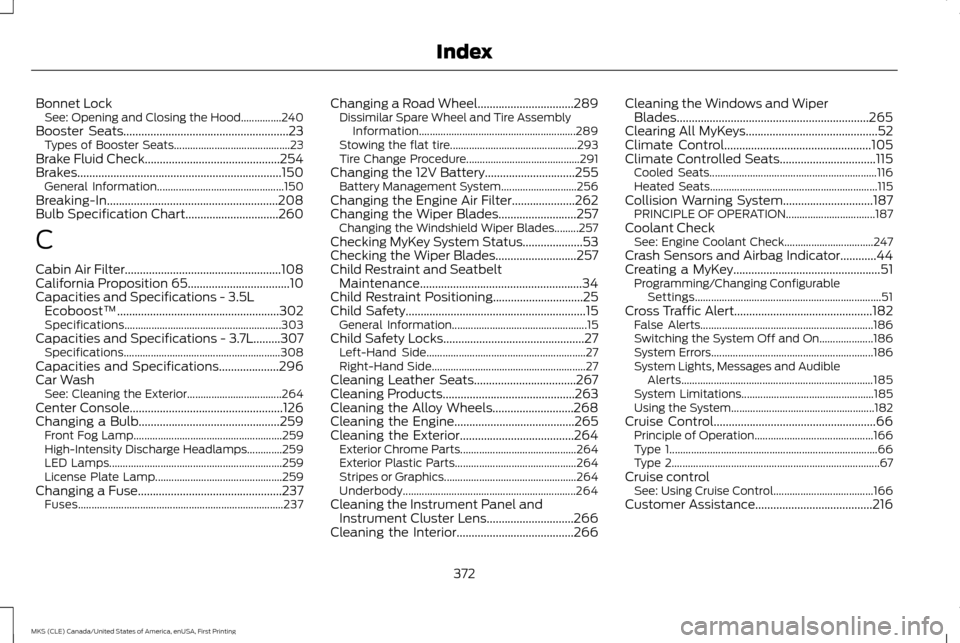
Bonnet Lock
See: Opening and Closing the Hood...............240
Booster Seats.......................................................23 Types of Booster Seats........................................... 23
Brake Fluid Check.............................................254
Brakes....................................................................150 General Information............................................... 150
Breaking-In.........................................................208
Bulb Specification Chart...............................260
C
Cabin Air Filter....................................................108
California Proposition 65..................................10
Capacities and Specifications - 3.5L Ecoboost™......................................................302
Specifications.......................................................... 303
Capacities and Specifications - 3.7L.........307 Specifications.......................................................... 308
Capacities and Specifications
....................296
Car Wash See: Cleaning the Exterior................................... 264
Center Console
...................................................126
Changing a Bulb...............................................259
Front Fog Lamp....................................................... 259
High-Intensity Discharge Headlamps.............259
LED Lamps................................................................ 259
License Plate Lamp............................................... 259
Changing a Fuse................................................237 Fuses........................................................................\
.... 237Changing a Road Wheel................................289
Dissimilar Spare Wheel and Tire Assembly
Information.......................................................... 289
Stowing the flat tire............................................... 293
Tire Change Procedure.......................................... 291
Changing the 12V Battery..............................255 Battery Management System............................ 256
Changing the Engine Air Filter.....................262
Changing the Wiper Blades..........................257 Changing the Windshield Wiper Blades.........257
Checking MyKey System Status....................53
Checking the Wiper Blades
...........................257
Child Restraint and Seatbelt Maintenance
......................................................34
Child Restraint Positioning..............................25
Child Safety............................................................15 General Information.................................................. 15
Child Safety Locks
...............................................27
Left-Hand Side........................................................... 27
Right-Hand Side......................................................... 27
Cleaning Leather Seats..................................267
Cleaning Products............................................263
Cleaning the Alloy Wheels...........................268
Cleaning the Engine........................................265
Cleaning the Exterior
......................................264
Exterior Chrome Parts........................................... 264
Exterior Plastic Parts............................................. 264
Stripes or Graphics................................................. 264
Underbody................................................................ 264
Cleaning the Instrument Panel and Instrument Cluster Lens.............................266
Cleaning the Interior
.......................................266 Cleaning the Windows and Wiper
Blades................................................................265
Clearing All MyKeys............................................52
Climate Control
.................................................105
Climate Controlled Seats................................115
Cooled Seats.............................................................. 116
Heated Seats.............................................................. 115
Collision Warning System..............................187 PRINCIPLE OF OPERATION................................. 187
Coolant Check See: Engine Coolant Check................................. 247
Crash Sensors and Airbag Indicator............44
Creating a MyKey
.................................................51
Programming/Changing Configurable
Settings..................................................................... 51
Cross Traffic Alert..............................................182 False Alerts................................................................ 186
Switching the System Off and On.................... 186
System Errors............................................................ 186
System Lights, Messages and Audible Alerts....................................................................... 185
System Limitations................................................. 185
Using the System..................................................... 182
Cruise Control
......................................................66
Principle of Operation............................................ 166
Type 1........................................................................\
..... 66
Type 2........................................................................\
..... 67
Cruise control See: Using Cruise Control..................................... 166
Customer Assistance
.......................................216
372
MKS (CLE) Canada/United States of America, enUSA, First Printing Index